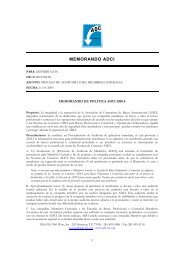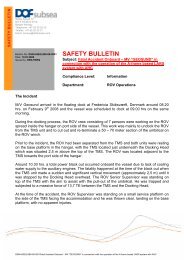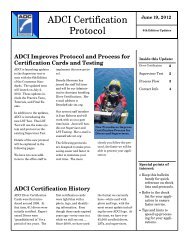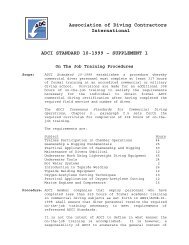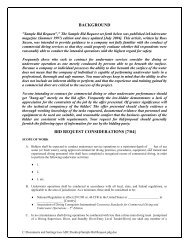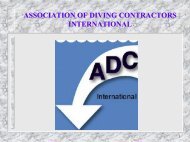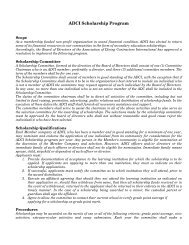DIRECTIVE NUMBER: CPL 02-00-151 EFFECTIVE DATE ... - OSHA
DIRECTIVE NUMBER: CPL 02-00-151 EFFECTIVE DATE ... - OSHA
DIRECTIVE NUMBER: CPL 02-00-151 EFFECTIVE DATE ... - OSHA
Create successful ePaper yourself
Turn your PDF publications into a flip-book with our unique Google optimized e-Paper software.
necessary assistance in a timely manner. The term “available” means to be<br />
clothed and equipped, and ready to enter the water at a moment’s notice. Gear<br />
such as face masks, air cylinders, and harnesses can be donned quickly, and<br />
need not be worn until the standby diver is required to enter the water.<br />
28. Surface-supplied air diving: A diving mode in which the diver in the water is<br />
supplied from the dive location with compressed air for breathing.<br />
29. Treatment table: A depth-time and breathing-gas profile designed to treat<br />
decompression sickness.<br />
30. Umbilical: The composite hose bundle between a dive location and a diver or<br />
diving bell, or between a diver and a diving bell, which supplies the diver or<br />
diving bell with breathing gas, communications, power, or heat as appropriate to<br />
the diving mode or conditions, and includes a safety line between the diver and<br />
the dive location.<br />
31. Volume tank: A pressure vessel connected to the outlet of a compressor and<br />
used as an air reservoir.<br />
32. Working pressure: The maximum pressure to which a pressure containment<br />
device may be exposed under standard operating conditions.<br />
C. 29 CFR 1910.410 Qualifications of dive team.<br />
1. The level of experience or training required by the standard depends upon the<br />
job the employees are required to do. All dive-team members must have either<br />
experience or training in the use of tools, equipment, systems, techniques,<br />
operations, operational procedures, and emergency procedures that are pertinent<br />
to, and necessary for, the assigned tasks for the diving mode (i.e., SCUBA,<br />
surface-supplied air, or mixed-gas diving). It is essential that those dive-team<br />
members who are exposed to hyperbaric conditions, or those members who<br />
control the exposure of others, have knowledge of the physiological effects of<br />
diving and the related effects of pressure. Accordingly, this standard also<br />
requires that employees be trained in diving-related physics and physiology.<br />
Employee qualifications achieved through field experience or classroom<br />
training, or both, may be used to meet the requirements of the standard. For<br />
example:<br />
a. Most divers begin as tenders and advance to diving status after a period of<br />
field experience and/or classroom training. A diving-tender trainee<br />
receiving on-the-job training will be assigned as a tender only under the<br />
supervision of a qualified diver.<br />
b. Tenders are members of the dive team who provide surface-support to<br />
divers at the diving location. A tender employed in shallow-water air diving<br />
is required to have a basic understanding of the breathing-air system, the<br />
operating and emergency procedures, and knowledge of the care and use of<br />
15


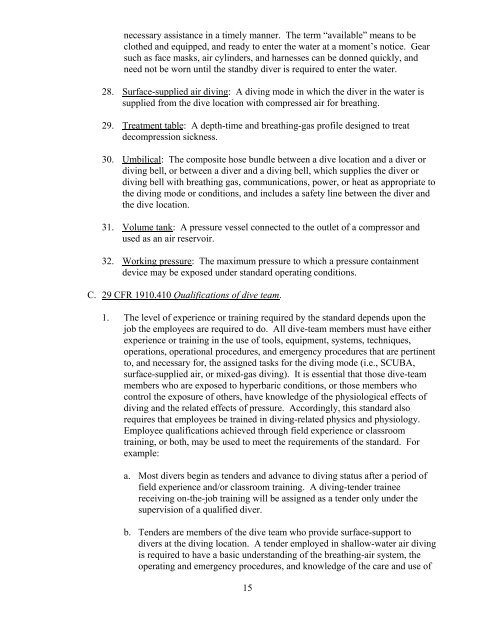
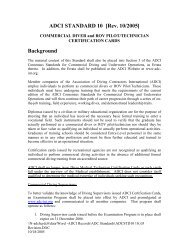
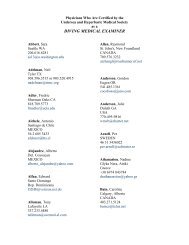
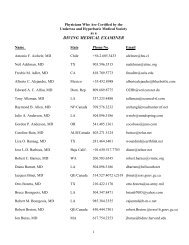
![SOLICITUD MEMBRESIA ASOCIADO [Rev 06/08] - Association of ...](https://img.yumpu.com/48291988/1/190x245/solicitud-membresia-asociado-rev-06-08-association-of-.jpg?quality=85)

